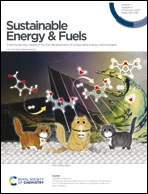Aluminum methylamidoborane complexes: mechanochemical synthesis, structure, stability, and reactive hydride composites†
Abstract
Methyl-substituted Al-based amidoborane Na[Al(CH3NHBH3)4] was designed and synthesized as a potential candidate for hydrogen-storage purposes. Its structure as well as that of Na[AlH(CH3NHBH3)3], forming as an intermediate in mechanochemical synthesis, were determined by high-resolution powder X-ray diffraction. The synthesis of Na[Al(CH3NHBH3)4] required the much cheaper CH3NH2BH3 and could be performed under less harsh conditions compared to the unsubstituted analogue. Na[AlH(CH3NHBH3)3] is the first example of an Al-based compound containing both hydride and amidoborane species. Despite Na[Al(CH3NHBH3)4] not being suitable for hydrogen storage on its own, reactive hydride composites (RHCs) made of Na[Al(CH3NHBH3)4] and 12 eq. of NaH, or 6 eq. of NaNH2, showed the release of pure hydrogen at moderate temperatures, making this and similar systems interesting candidates for hydrogen storage.



 Please wait while we load your content...
Please wait while we load your content...